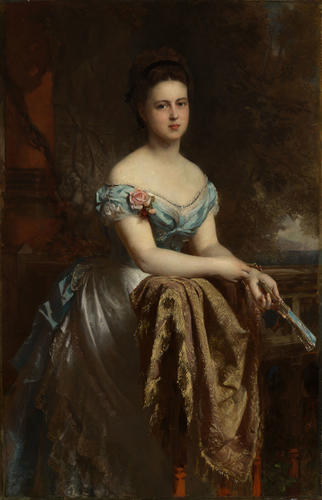-
1 of 253523 objects
Marie, Duchess of Edinburgh, Grand Duchess of Russia (1853-1920) Signed and dated 1873
Oil on canvas | 145.8 x 94.7 cm (support, canvas/panel/stretcher external) | RCIN 405024

Gustav Karl Ludwig Richter (1823-84)
Marie, Duchess of Edinburgh, Grand Duchess of Russia (1853-1920) Signed and dated 1873
-
On 18 January 1874, Queen Victoria, writing from Osborne House, recorded that the ‘Feldjäger’ (the Queen’s messenger) had arrived, bringing ‘the long expected portrait of her [Maria], which is a gift from the Emperor. It is a lovely picture ½ length, and beautifully painted. She is standing on a balcony in a light blue evening dress, with a fan in her hand.’ It appears that dispatch of the portrait was delayed because miniatures from the image were being painted as official presents from the couple. Days later, the Queen praised the likeness as ‘beautiful & quite worthy of Winterhalter’, and on the day of her son Alfred’s wedding to the sitter in St Petersburg, the picture was ’surrounded by a wreath of evergreens & some orange flowers, tied with bows of the Russian colours’, in honour of the occasion. Up until this point, the Queen had only seen photographs of her future daughterin-law, and when she arrived at the English court soon after the wedding, views of her personality were sometimes less than complimentary. However, assimilation into the British Court was challenging for Marie, as it differed significantly with the Court of St Petersburg, and this resulted in tensions and perceived snubs.
The German painter, Gustav Richter, who had studied in Berlin and was later a pupil of Léon Cogniet (1794–1880) in Paris, worked on the portrait during the late autumn of 1873 at Livadia Palace, near Yalta. The Grand Duchess was aged 20 at the time and later loathed having to sit for her portrait, conscious of her looks and figure. When painted by Carl Rudolph Sohn (1845–1908) in 1884, she described the experience as a ‘great bore’, and an ‘aggravation of sorrow’ (RCIN 404784).
The portrait was sent away to Georgina Koberwein Terrell (1853–1903) on three occasions between 20 December 1890 and 17 June 1891 for copying, and a copy was given by the Queen to the Duke of Edinburgh for his birthday. The painting is recorded in a photograph of c.1890 hanging in the Oak Room, Windsor Castle, together with other portraits of Queen Victoria's daughters-in-law; their Gothic revival frames presumably commissioned for this ensemble (RCIN 2935640).
A photogravure print was made after the portrait (RCIN 606066), and the Royal Collection also holds a copy on porcelain (RCIN 401436), and a bust-length miniature by David Mossman (RCIN 420335).
Gustav Karl Ludwig Richter (1823-1884) was a pupil of Eduard Holbein at the Academy in Berlin. He became a pupil of Leon Cogniet in Paris, before moving to Rome, where he lived from 1847 to 1849. After travelling to Egypt, he painted the Construction of the Pyramids, (1859–72, Maximilianeum, Munich), commissioned by the King of Bavaria. In 1860, he became a member of the Academy in Berlin, and later began to devote himself to portraiture, of which his Queen Louise of Prussia (1879, Cologne Museum) is perhaps his best known.
A charcoal outline sketch of the Princess, facing the left, is on the reverse.
Text adapted from Russia: Art, Royalty & the Romanovs, London, 2018Provenance
Given to Queen Victoria by Emperor Alexander II; recorded at Windsor Castle in 1878
-
Creator(s)
(framemaker)(nationality)Acquirer(s)
-
Medium and techniques
Oil on canvas
Measurements
145.8 x 94.7 cm (support, canvas/panel/stretcher external)
163.6 x 118.0 x 8.0 cm (frame, external)